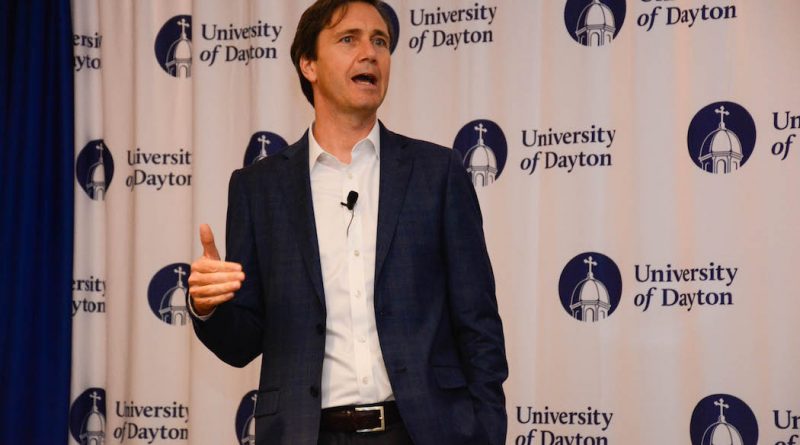Featured Speaker Richard Reeves Talks Inequality, ‘Dream Hoarders’ And The Upper Middle Class
Emily Battaglia
Contributing Writer
According to a study published by the New York Times, 69 percent of University of Dayton students have a median family income of $149,600. This makes seven out of 10 students at UD part of the top 20 percent of the socioeconomic pyramid, referred to as the upper middle class.

Richard Reeves, a senior fellow of economic studies at the Brookings Institution, addressed this group of people in his book “Dream Hoarders,” and discussed ideas from it during his presentation in Kennedy Union Ballroom on Oct. 15.
Reeves, a British American, was inspired to write his book after President Barack Obama’s proposed reform for 529 tax benefits in 2015 was dropped. This proposal involved the end of 529s, a tax-advantaged way to save for college education. The reason for this plan’s abrupt end? The federal program disproportionately benefits upper middle class families, who Reeves claims are more effective at maintaining their economic position than any other class.
“The class system in the U.S. was much stronger than I thought before moving here. In fact, I think it’s stronger than the class system in the U.K.,” Reeves said. “On a daily basis, the U.S feels like a more classless society. But when it comes to the hard facts of it, the U.S. is ruthlessly effective at replicating class status — especially at the top twenty percent. They’ll use any number of systems to sustain themselves in place – which is understandable from a self-interest point – but which actually belittles the notion of equal opportunity in a classless society.”
Reeves classifies the top 20 percent as any household income that makes at least $130,000 per year. Oftentimes, though, they are camouflaged as a group that has not seen significant growth over the past few decades. When the top one percent is removed from income growth comparisons, the flat line that once was the growth of the upper middle class becomes a steep incline—proving just how upwardly mobile this class has been.
While Reeves pointed to a number of reasons for this group’s continued financial ascent, he cited higher education as being one of the most significant. In fact, a graph Reeves displayed showed college attendance and rate of income had a correlation coefficient of .675, which exemplifies how easy it is to predict whether or not a student will attend college based on their family income.
“Higher education is where the rubber hits the road. In the U.S. you really see this very strong class fracture open up at the post-secondary level,” Reeves said in an interview with Flyer News. “By shifting the dial a little bit around post- secondary, we’ll get quite big results. I think if you can get lower and middle income kids to and through post-secondary it transforms their life chances…higher education is the great equalizer in theory and the great stratifier in practice.”

Two other major problems Reeves cited with higher education were the legacy admissions system and the allocation of internships based on familial ties. Because both practices involve rigging the market for privileged students, according to Reeves, they exemplify the “opportunity hoarding” the upper middle class repeatedly partakes.
Reeves said there are two ways to end this issue. Looking at college internships, he stated they should be more regulated. Many internships are unpaid, and certain paid internships could be taking a job from someone else and giving it to a less qualified student solely because of socioeconomic connections.
Reeves admitted the change must involve direct sacrifice from the upper middle class. Once society begins to recognize these things are unacceptable, Reeves said attitudes and social norms will change. He predicts this transition to slowly occur over time, as the U.K. was able to shift societal attitudes toward internships in roughly 20 to 30 years.
“I think that [legacy preference] will also go really quickly,” Reeves said. “There’s this kind of weird stalemate at the moment around college admissions…nobody really understands it and it’s completely corrupt and weird…I think privately a lot of these institutions that practice legacy admissions would rather not, they just say they can’t not be doing it while everybody else is doing it–so it’s a collective action problem.”

These notions call into question the values our university abides by as a Catholic Marianist institution. Because this campus has such a high population of upper middle class students, the opportunity to enact change starts now, according to the economist. Reeves said if UD is serious about the common good, then we should be willing to make these sacrifices.
“I think some of these practices could be described as unchristian,” Reeves said. “If you can’t ask for a little bit of sacrifice from an institution with a Catholic history, where can you ask for a little bit of sacrifice?…Each of us has to start in our own shoes…we have to start where we are.”
Reeves was the second presenter in UD’s Fall 2018 Speaker Series. An article about the first speaker, author and journalist Wil Haygood, is available here. The third and final speaker is Iranian- American actor, comedian and author Maz Jobrani. His speech will be in Kennedy Union Ballroom from 7-8:30 p.m. on Nov. 14.
Photos courtesy to Kristin Davis.

